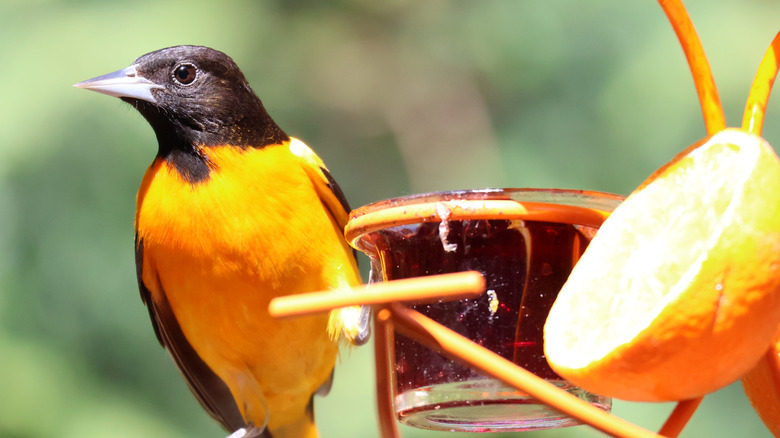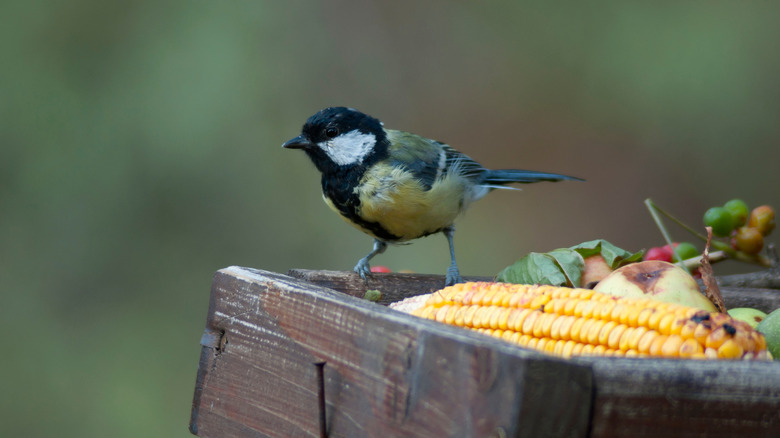These Backyard Snack Boards For Birds Are Too Cute To Ignore
If you get excited whenever someone breaks out the cheese or charcuterie tray, you might want to spread the same cheer to your birds. Liven up your backyard bird feeder by putting out a snack board for your feathered friends. You can make it as elaborate or as simple as you want. Create a fancy, artfully arranged, Insta-worthy creation by using a handcrafted tray and fancy dishes. You can use thrift store finds or raid the back of your cabinets for odds and ends.
If Lunchables are more your style than artisanal charcuterie displays, you can use whatever you happen to have lying around to attract more birds to your yard. You can even make your own platform feeder by nailing four small lengths of wood together, then staple a metal window screen to the bottom for a floor. Using a screen for the bottom allows water to drain through, so your birds' food isn't sitting in a puddle and getting soggy. Drill holes on each side and add twine to hang your feeder.
You can attract the type of birds you want in your yard with platform bird feeders because they allow you to add different types of food. Many bird feeders are specialized to provide one specific type of seed, which can limit your visitors. What makes this snack board so great is the variety of items you can include on it, inviting an array of different winged species to your yard. Put out black oil sunflower seeds as a base to appeal to birds such as cardinals, chickadees, nuthatches, titmice, mourning doves, grosbeaks, jays, and woodpeckers.
What to include on your bird charcuterie board
To arrange your snack board, start by placing the largest items first, then add in other snacks for variety. Nuts are calorie-dense snacks that give birds plenty of energy. Make sure you only put out shelled, unsalted nuts. You can offer peanuts, walnuts, Brazil nuts, or macadamia nuts. Attract acorn woodpeckers by adding some acorns. As a bonus, this can be a free source of food for your bird snack board if you live in an area where oak trees are abundant.
Add fruit to your board for orioles, catbirds, thrushes, and waxwings. Unlike your kids, who are likely to leave that orange you packed at the bottom of their lunchboxes, the birds will appreciate it. You can put out any type of fruit that's safe for humans to eat, so chop up whatever you have in your produce drawer. Birds aren't as picky as humans about the ripeness of fruit, either. They'll eat it whether it's under- or overripe. Some birds have been seen indulging in fermented fruit until they're intoxicated — the bird equivalent of wine with their charcuterie. However, you should avoid getting your birds drunk, since it can make them prone to accidents and easier targets for predators.
Finally, add in some treats like dollops of jelly, suet balls, and dried or live mealworms. Like all sweets, jelly should be given sparingly. Put a tablespoon or so in a small dish so the birds won't step in it and get sticky, which can compromise their ability to fly. Avoid any type of sugar-free jelly, since birds can't digest artificial sweeteners.
Tips on placing and maintaining your bird snack board
The ideal spot for your snack board is a shaded area where you can easily see it. Watching your feathered friends chow down is the reward for all of your effort. Be aware that food that is appealing to birds will also be appealing to squirrels, chipmunks, and other uninvited guests. If your party is exclusively for the birds, you can discourage them by mounting a platform feeder on a pole with a squirrel baffle. However, you'll also need to make sure the squirrels can't access the feeder from nearby trees or other structures. These little acrobats are clever and known for thwarting measures meant to keep them away from their favorite snacks.
If your tray doesn't have drainage, it will need more maintenance to keep the food fresh. You can drill holes in the bottom of a wooden tray or manually drain it when necessary. Plan to properly clean your backyard bird feeder every three to five days — more often in hot weather. Stop adding food before you plan to wash the feeders so the birds can "clean their plate" and reduce waste. Wear disposable gloves when you're cleaning your feeders. Remove and dispose of any remaining food. Wash all of the dishes in hot water and dish detergent, scrubbing the cracks and crevices to remove buildup and debris. Allow everything to dry completely before hanging and refilling.

